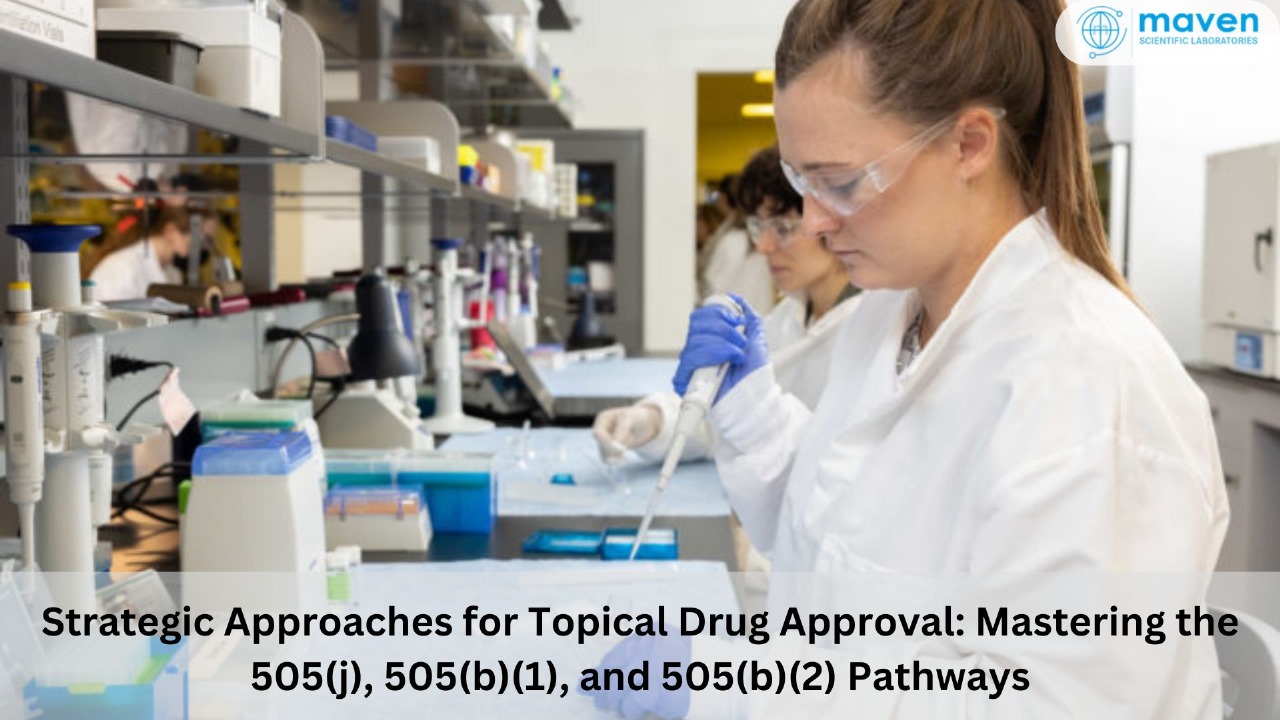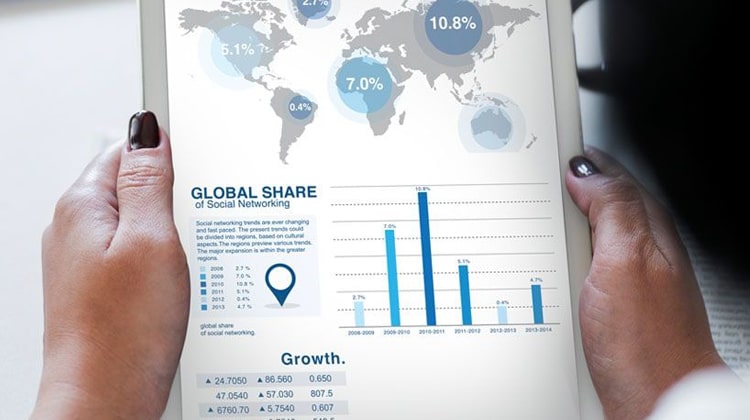
Strategic Approaches For Topical Drug Approval: Mastering The 505(j), 505(b)(1), And 505(b)(2) Pathways
The pharmaceutical industry offers several regulatory pathways to gain approval for drug products, tailored to accommodate generic drugs, novel drug entities, and modified drug formulations. Among these, the 505(j), 505(b)(1), and 505(b)(2) applications serve as crucial frameworks for manufacturers, especially in the case of topical drug formulations where biowaivers can expedite approvals by bypassing in vivo studies. Maven, with its extensive regulatory expertise, specializes in supporting clients with 505(j) submissions and securing biowaivers for topical formulations. This blog delves into the nuances of these pathways, Maven’s specialized services, and a real-world case study showcasing our capabilities.
Overview of Regulatory Pathways: 505(j), 505(b)(1), and 505(b)(2)
505(j): The Generic Drug Pathway
Definition: The 505(j) pathway is employed for Abbreviated New Drug Applications (ANDAs), facilitating the approval of generic drugs that demonstrate bioequivalence to a Reference Listed Drug (RLD).
Key Features:
- Bioequivalence Focus:
Generic drugs must exhibit no significant difference in the rate and extent of absorption compared to the RLD.
- Replication of RLD Characteristics:
The active ingredient, strength, dosage form, and route of administration must mirror the RLD.
- Streamlined Development:
Reduces development costs and timelines as extensive preclinical and clinical studies are not required.
- Market Exclusivity:
Grants six months of market exclusivity to the first generic approved under Paragraph IV certification.
- Regulatory Timelines:
ANDA preparation and review typically span 16–26 months, depending on formulation complexity and regulatory interactions.
505(b)(1): The New Drug Pathway
Definition: This pathway supports New Drug Applications (NDAs) for innovative drug entities, requiring comprehensive preclinical and clinical studies to establish safety and efficacy.
Key Features:
- Suitable for novel drug molecules.
- High investment with longer timelines (5–7 years).
- Grants up to seven years of market exclusivity.
505(b)(2): The Modified Drug Pathway
Definition: The 505(b)(2) pathway is designed for drugs that are modifications of existing drugs, leveraging previously submitted clinical data with supplemental studies.
Key Features:
- Ideal for new formulations, strengths, or routes of administration.
- Cost-efficient with approval timelines of 2–3 years.
- Offers market exclusivity for three to five years.
|
Aspect |
505(j) |
505(b)(1) |
505(b)(2) |
|
Type of Drug |
Generic drugs |
Novel drugs |
Modified drugs |
|
Data Requirement |
Bioequivalence |
Full clinical data |
Combination of existing and new data |
|
Innovation Level |
Minimal |
High |
Moderate |
|
Approval Time |
10–18 months |
5–7 years |
2–3 years |
|
Cost |
Low |
High |
Moderate |
|
Market Exclusivity |
6 months (first generic) |
Up to 7 years |
3–5 years |
Topical Biowaivers: Accelerating Generic Approvals
Biowaivers eliminate the need for in vivo bioequivalence studies, offering a cost-effective and expedited approval route for topical formulations. This is particularly advantageous for drugs with minimal systemic absorption.
Key Criteria for Topical Biowaivers
- In Vitro Equivalence:
Demonstration of comparable performance between the generic and RLD via in vitro methods such as drug release and permeation studies.
- Qualitative and Quantitative Similarity (Q1/Q2):
The formulation must replicate the qualitative composition and achieve similar quantitative proportions of inactive ingredients.
- Physicochemical Characterization:
Includes assessments of parameters like pH, viscosity, particle size, and appearance.
Advantages of Topical Biowaivers
- Cost-Efficient:
Avoids expensive and time-intensive in vivo studies.
- Expedited Approvals:
Streamlines regulatory submissions, reducing timelines significantly.
Documentation Requirements for 505(j) Topical Biowaivers
- Comprehensive Q1/Q2 Analysis Data
- In Vitro Equivalence Study Reports
- Physicochemical Property Testing Results
- Stability Testing Data
- Impurity Profile and Analytical Method Validation
- Complete ANDA Dossier (in eCTD format)
- Patent Certification (e.g., Paragraph IV Certification)
Maven’s Expertise in Securing Topical Biowaivers
Maven offers end-to-end solutions for obtaining topical biowaivers under the 505(j) pathway. Our services include:
Q1/Q2 Analysis and Formulation Support
- Thorough evaluation to ensure qualitative and quantitative alignment with the RLD.
- Expert guidance on optimizing formulations to meet regulatory standards.
In Vitro Equivalence Studies
- Conducting and documenting drug release and permeation tests.
- Generating robust data to support bioequivalence claims.
Advanced Physicochemical Characterization
- Testing parameters like pH, viscosity, and particle size distribution.
- Ensuring consistency and compliance with FDA guidelines.
Regulatory Documentation and Submission
- Preparation of comprehensive ANDA dossiers.
- Expert handling of FDA queries and supplemental data submissions.
Case Study: Successful Topical Biowaiver for a Generic Cream
Client Objective: A client approached Maven to secure a topical biowaiver for a generic antifungal cream using the 505(j) pathway.
Challenges:
- Achieving Q1/Q2 similarity with the RLD.
- Conducting in vitro equivalence studies to substantiate bioequivalence.
Maven’s Solution:
- Conducted a detailed Q1/Q2 analysis to ensure ingredient alignment.
- Performed rigorous in vitro drug release and permeation studies.
- Compiled a comprehensive ANDA dossier with all required data.
Outcome:
- The FDA granted the biowaiver request based on the submitted evidence.
- Approval was achieved within 14 months, significantly reducing time and cost.
Why Choose Maven?
Maven stands out for its:
- Regulatory Precision: Expertise in global regulatory standards ensures seamless submissions.
- Cost and Time Optimization: Efficient strategies to reduce development expenses and approval timelines.
- Proven Track Record: Successful execution of biowaivers across various dosage forms, including topicals.
- Comprehensive Support: From formulation to submission, we provide tailored solutions for each client.
Conclusion
Topical biowaivers offer a streamlined pathway to approval, especially under the 505(j) framework for generic drugs. Maven’s expertise in securing these biowaivers ensures clients benefit from faster approvals, reduced costs, and regulatory success.
Contact Maven today to learn more about how we can assist with your 505(j) submissions and topical biowaivers.







